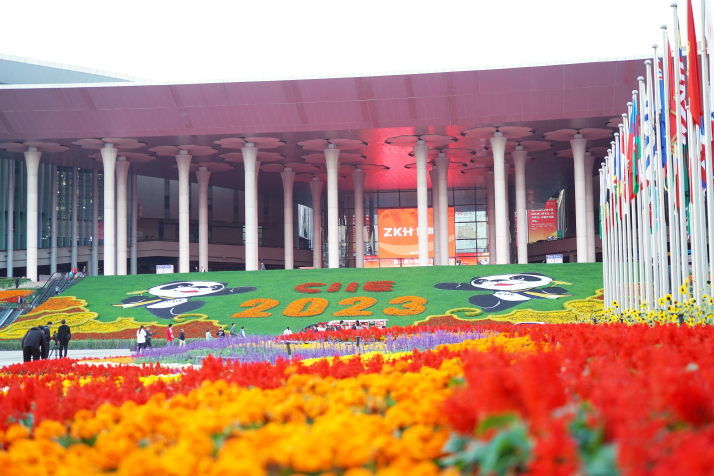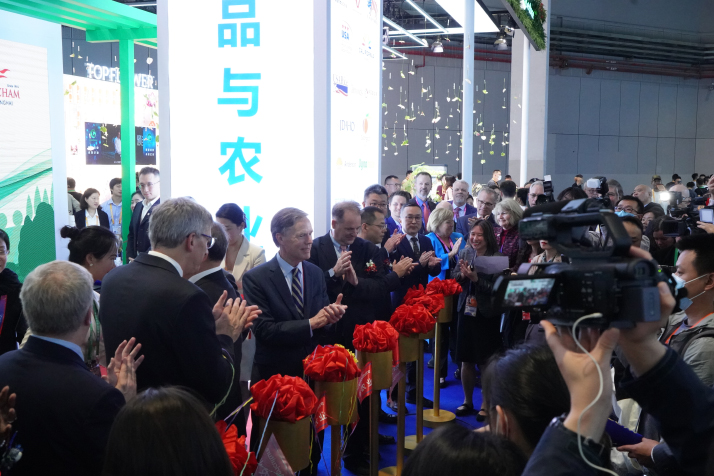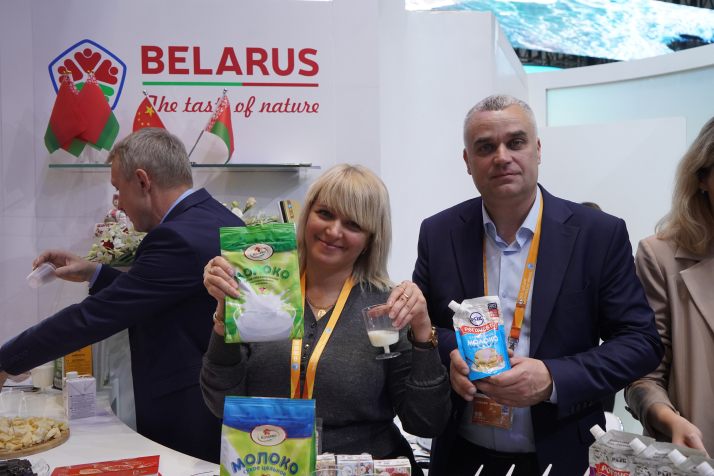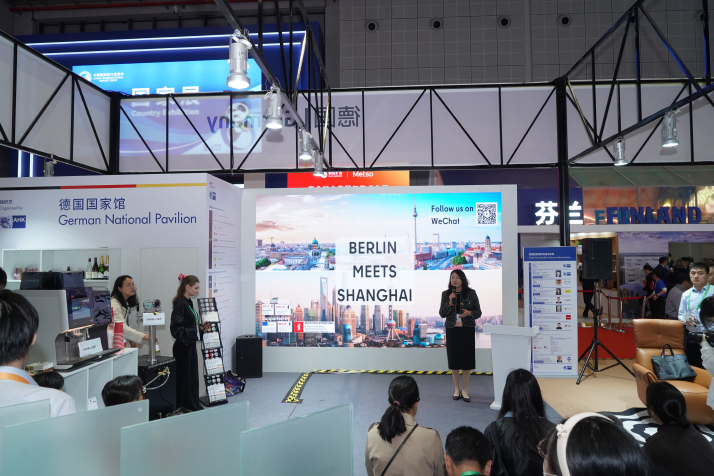| Business |
| CIIE in Shanghai shatters boundaries and explores the global stage | |
|
|
 The south square of the National Exhibition and Convention Center, the main venue for the China International Import Expo (CIIE), in Shanghai (YIN KANG)
On its opening day on November 6, the American Food and Agriculture Pavilion at the Sixth China International Import Expo (CIIE) in Shanghai was bustling with activity as visitors flocked to explore and sample a wide range of products, including coarse sea salt, California wines, soybeans, cheeses, nuts, berries and more—even chocolates for pets.  The opening ceremony of the American Food and Agriculture Pavilion at the Sixth CIIE in Shanghai on November 6(YIN KANG)
Keith Schneller worked tirelessly, navigating between booths and personally guiding visitors through the exhibit. A senior trade policy specialist for the Almond Board of California, this was his team's first time exhibiting at the CIIE. One of the first American agricultural associations to enter the Chinese market, the board has more than 7,000 almond growers in the state of California. All of its almonds are grown exclusively in the state of California, which produces 80 percent of the world's total. "China is our third largest export market in the world," Schneller told Beijing Review. "We understand it's a very, very important expo for companies to come and show their products and find new buyers, and we really want to let our Chinese customers know that we're here for the long run. We hope to attend again next year!"  Exhibitors from Belarus showcase their products at their national pavilion at the Sixth CIIE in Shanghai on November 8(YIN KANG)
The Sixth CIIE unfolded in Shanghai from November 5 to 10, the first fully in-person edition since the outbreak of the COVID-19 pandemic. The world's first national-level import exhibition, the CIIE's previous five editions achieved a cumulative intended transaction value of nearly $350 billion and presented about 2,000 first-time products. This year's edition set new records in the six-year history of the expo. With more than 3,400 exhibitors and 394,000 registered professional visitors, an exhibition area of about 367,000 square meters for commercial enterprises, the participation of 289 Fortune Global 500 and industry-leading companies, and more than 400 new technologies, products and services on display, the expo surpassed the levels of the previous five editions. Across the expo's exhibition areas, from food to fashion, foreign companies seemed to be embracing the integration of Chinese elements into their products as a means of innovation, hoping to better resonate with Chinese consumers and achieve higher market returns.  The Berlin business delegation to the Sixth CIIE hosts a product launch at the German National Pavilion on November 8 (YIN KANG)
Largest U.S. presence The Sixth CIIE witnessed the largest-ever delegation from the United States. Jointly set up by the U.S. Department of Agriculture and the American Chamber of Commerce in Shanghai, the U.S. Food and Agriculture Pavilion covers an area of more than 440 square meters. A total of 17 exhibitors from the U.S. state governments, agricultural product associations, agricultural exporters, food manufacturers and packaging companies showcased their products at the pavilion, the country's first national-level exhibition hall in the expo's history. "We are not in favor of decoupling these two economies. We want greater trade," U.S. Ambassador to China Nicholas Burns said on November 6 in a speech at the opening ceremony of the American Food and Agriculture Pavilion. The U.S and China have an "extraordinarily important economic and trade relationship," Burns said, noting that China is the largest destination for American exports and is the largest U.S. trade partner after Mexico and Canada. Eric Zheng, President of the American Chamber of Commerce in Shanghai, said he believes that the presence of the largest U.S. delegation ever at the CIIE demonstrated the diversity of the economic and trade relations between the two countries. This edition of the expo welcomed more than 200 participating companies from the U.S., with a significant number of them representing industries such as semiconductors, medical equipment, new-energy vehicles and beauty products. Over the past six years, U.S. exhibitors have consistently ranked among the CIIE top, both in terms of the space occupied and the number of companies represented. Among them are a large number of long-time exhibitors who have firmly established themselves in the Chinese market. More localization The CIIE Food and Agricultural Products Exhibition Zone is one of the most popular exhibition areas each year. Following the tantalizing aroma and long lines, it's easy to find the Tyson Foods booth in the zone. The wide variety of meat products available for sampling has long made this one of the most popular booths in the area. The global meat industry giant continues to advance its localization strategy in China. "We have introduced innovative solutions tailored to meet the evolving needs and preferences of Chinese consumers in different consumption settings," said Pan Weijing, the exhibitor from Tyson Foods Inc. At this year's edition, Tyson Foods unveiled a series of high-quality protein-based new products, including crispy chicken drumsticks and caramelized chicken wings drizzled with organic honey. Making their global debut at the CIIE, these new products are specifically designed to cater to emerging consumption scenarios in the Chinese market, as consumers increasingly demand high-protein, low-fat food products. Roy van den Hurk, 68-year-old CEO of Milk New Zealand Dairy Ltd., has attended the CIIE for six consecutive years and the brand has become a leader in imported dairy products in China. "The CIIE is a great opportunity, especially for a country like New Zealand, to sell products into the Chinese market," he said. This year, his company presented the Chinese premiere of New Zealand 4.0 Jersey Fresh Milk, an upgraded version of the star exhibit from the inaugural CIIE: New Zealand 72-Hour Fresh Milk. "I have confidence that this new product will also achieve the remarkable feat of reaching Chinese consumers' dining tables within 72 hours, starting from the milking process on the farm," he told Beijing Review. His annual CIIE vlog has also gained popularity on YouTube. "If you want to get close to the market, if you're trying to sell, you have to actually go there and meet all the people involved," he said. The six-year journey of participating in the CIIE has given the milk brand a competitive advantage in the Chinese market. Before 2017, due to factors such as traditional logistics and customs inspections, fresh milk products from New Zealand took about seven to eight days to reach China, going through a series of customs clearance processes. As a result, imported fresh dairy products did not have a significant competitive advantage in the Chinese market at that time. But the CIIE's trade facilitation policies introduced in 2017 marked a turning point for foreign companies. As one of the first trade facilitation pilot companies in Shanghai, Milk New Zealand Dairy took advantage of these policies to solve the fresh milk clearance bottleneck. As a result, they were able to reduce customs clearance time so that the imported fresh milk can reach Chinese customers within just three days. New, old friends The CIIE is a platform where one sees familiar faces and makes new connections. "We are sure that Louis Dreyfus will continue to be in a positive position in terms of China's opening up, and we will see a win-win situation in terms of China's further opening up," Michael Gelchie, CEO of Louis Dreyfus Co. Ltd., a global agricultural trading and processing company headquartered in the Netherlands, told Beijing Review during this year's expo. Having been a part of the Chinese market for more than 50 years, the company will continue to invest heavily in China as it sees future growth in this market, Gelchie added. This year was the fourth time that French luxury goods company LVMH Group participated in the CIIE. The group brought along 12 iconic brands to the expo, including Dior, Louis Vuitton and Fendi. Notably, high-end fashion label Celine and luxury clothing and shoe company Loewe made their expo debut. Italian jewelry house Bvlgari attended for the fourth time. On this occasion, CEO Jean-Christophe Babin signed a memorandum of cooperation with representatives of China's Hainan Integrated Free Trade Zone Administration Committee, officially announcing Bvlgari's establishment in the Hainan Integrated Free Trade Zone. Like old friends, the many luxury brands in attendance made their presence felt at this year's CIIE—in different ways. Some integrated a touch of traditional Chinese culture into their products, while others followed the latest trends or showcased their engagement with local communities in China. All in all, these brands showed off their classic brand culture, adding a touch of localization to highlight the appeal of cultural exchange. BR (Reporting from Shanghai) Copyedited by Elsbeth van Paridon Comments to taozihui@cicgamericas.com |
|
||||||||||||||||||||||||||||
|